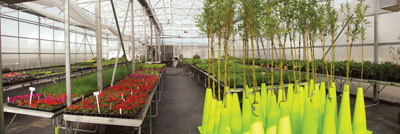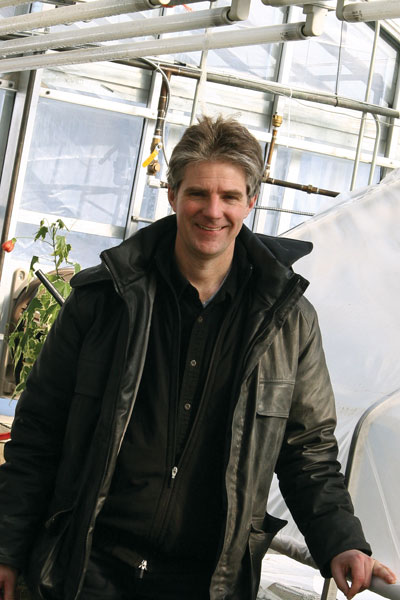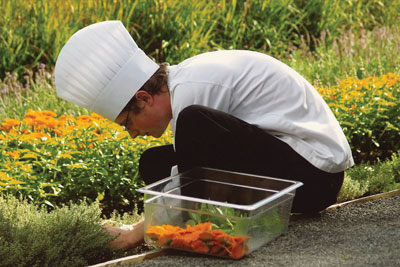
In 1918, Elsie Reford took possession of a summer camp in Grand-Métis,
located in the eastern part of Québec and with a magnificent view of the
St. Lawrence River.
In 1918, Elsie Reford took possession of a summer camp in Grand-Métis, located in the eastern part of Québec and with a magnificent view of the St. Lawrence River.
 |
|
| Each variety is grown in small quantities of 50 to 100 plants. Advertisement
|
In 1926, she expanded Estevan Lodge, built by her uncle Lord Mount Stephen in 1887, and transformed it into a 37-room country house. Over four decades, she created a private garden and grew many varieties of flowers that did not flourish naturally in this part of the world.
Her son, however, didn’t have her horticultural passion or her green thumb. He sold the property to the provincial government in 1961, and the gardens were opened to the public the following year.
Reford Gardens has since become an important tourist attraction in the Gaspésie. In 1995, the government transferred the site to the management of a non-profit organization. The board hired Elsie Reford’s great-grandson Alexander Reford as general manager. He left his job at the University of Toronto, and career as a historian, to live a new life in the heritage settings established by his own family.
Reford Gardens (Les Jardins de Métis) is open from June through October each year. It is celebrating its 50th year as a public attraction this year. Featured will be concerts, garden parties, theatrical performances, lectures, circus events, culinary evenings, literary teas and musical brunches. It will also host the 13th edition of the International Garden Festival, featuring the work of artists from around the world.
STARTING PLANTS IN THE GREENHOUSE
■ From its early days, Reford Gardens has used greenhouses to start exotic seeds such as the blue poppy.
 |
|
| General manager Alexander Reford.
|
“Greenhouses have always been essential for us because of our northern climate, and also because we produce more than 23,000 different annuals and perennials every year,” says horticulturalist Patricia Gallant.
She has been in charge of production for the past 24 years.
“Each year, we try new varieties. For instance in our 2012 season, we will, among many others, plant new selections never rooted here such as angelonia, antirrhinum majus, browallia americana, cosmos rubenza, dianthus ‘Amazon Rose Majic,’ California poppy, and ‘Spanish Eye Lavender.’”
Assisted by four gardeners and an assistant gardener, this is a complex task for Gallant and her colleagues because each variety is grown in very small quantities. “Most of the time, it means 50 to 100 plants.”
Reford Gardens has three greenhouses. Two are Lord and Burnham structures, built in 1972. Each measuring 30×30 feet, they are heated by a hot water system. The third structure, a Harnois Nordique, was purchased when the province closed the Quebec City zoo in 2006; it is a double greenhouse that measures 40×75 feet and has a propane heating system.
CONSIDERING SWITCH TO BIOMASS HEATING
■ “We are looking at a biomass heating system since there are many suppliers in our region with many sawmills nearby,” says Reford. “This is a project that could be feasible in 2013 or 2014.”
And while talking about suppliers, Premier Tech has been an important sponsor over the years. “They give us all the compost, peat moss and substrates that we need,” Reford adds. “It amounts to a substantial contribution to our growing operations.”
Heating and lighting are major challenges each February when the growing season begins.
“This is very complicated,” says Gallant. “I have to find the right place for each variety, taking into account the sun and the lighting. We have to count on natural light, since we only have fluorescents.”
Plants are moved around the greenhouse throughout their various growth stages. And with the number and variety of plants grown, that keeps everyone hopping.
Crop start times vary because temperatures are not the same in the three main greenhouses.
“In one of the greenhouses heated by a hot water system, we set the temperature between 20 and 24 Celsius, while in the other one, we will heat only between 15 and 20 Celsius. In the third, the temperature is much lower, kept between 12 and 15 Celsius,” adds Gallant.
A fourth structure is not heated. It’s used for some varieties just before they are transplanted in the garden.
All irrigation is done manually.
PEST MANAGEMENT RELIES ON BIOCONTROLS
■ “We don’t use any pesticides,” says Gallant. Predators such as amblyseius cucumeris, hypoaspis aculeifer, cryptolaemus montrouzieri, hypoaspis miles and amblyseius swirskii are used, and with good success.
The 23,000 varieties grown require close monitoring, and Gallant has created a detailed production database.
“I also numbered all the flowerbeds, and detailed the type of soil and the exposure to the sun, because each part of the garden has its own characteristics.”
The historic section of the gardens – the area that was maintained from 1926 until 1958 by the Refords – is still home to the same varieties grown back then. “We want to respect the original setup in the historic garden, so we maintain the same varieties over the years,” Reford explains.
The newer sections of the gardens have been developed as conceptual gardens created as part of the International Garden Festival.
FINE CUISINE PAIRED WITH FINE FLOWERS
■ There are two cafés and a restaurant in Estevan Lodge, the historic fishing lodge and former summer house of Elsie Reford. Pierre-Olivier Ferry, the chef since 2005, has created original dishes made with flowers and herbs grown onsite. He can choose from among 120 varieties to use in his recipes.
 |
|
| Pierre-Olivier Ferry has been chef of the restaurant and the two cafés at the Reford Gardens since 2005. He extensively utilizes flowers and herbs grown onsite. PHOTO COURTESY REFORD GARDENS |
One appetizer, for example, includes petals from about 15 varieties of flowers. Several main courses are also garnished with flowers and herbs grown in the gardens. Marinades and spreads made with flowers, fruits and herbs from the garden and surrounding area are also available on the site, but also sold through a network of specialty stores and restaurants around the province.
And finally the big question: how does Alexander Reford feel about managing a garden created by his great-grandmother almost a century ago? “This is a choice I have never regretted!”
Martine Frigon is a freelance writer and photographer in Quebec.
Print this page